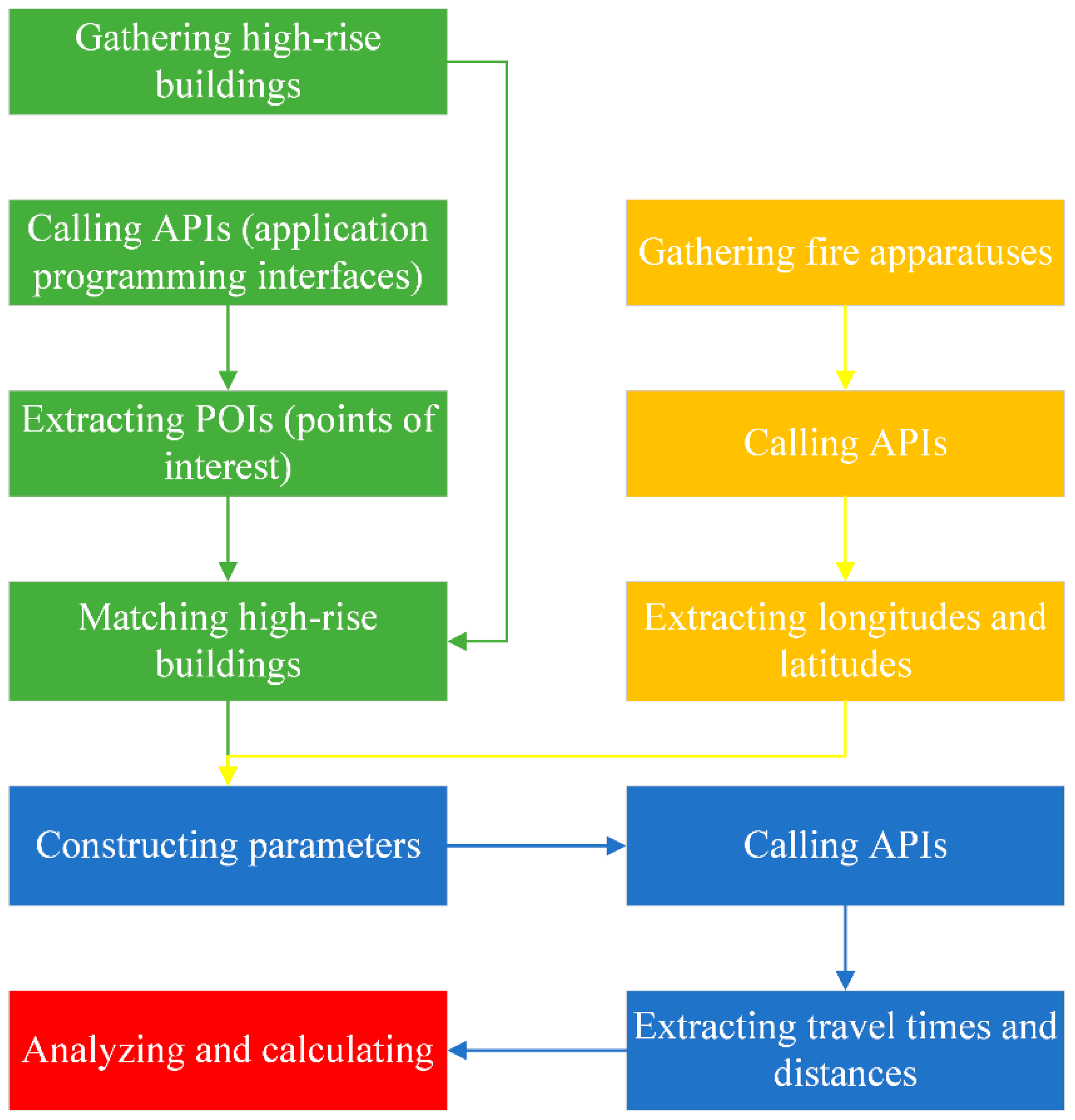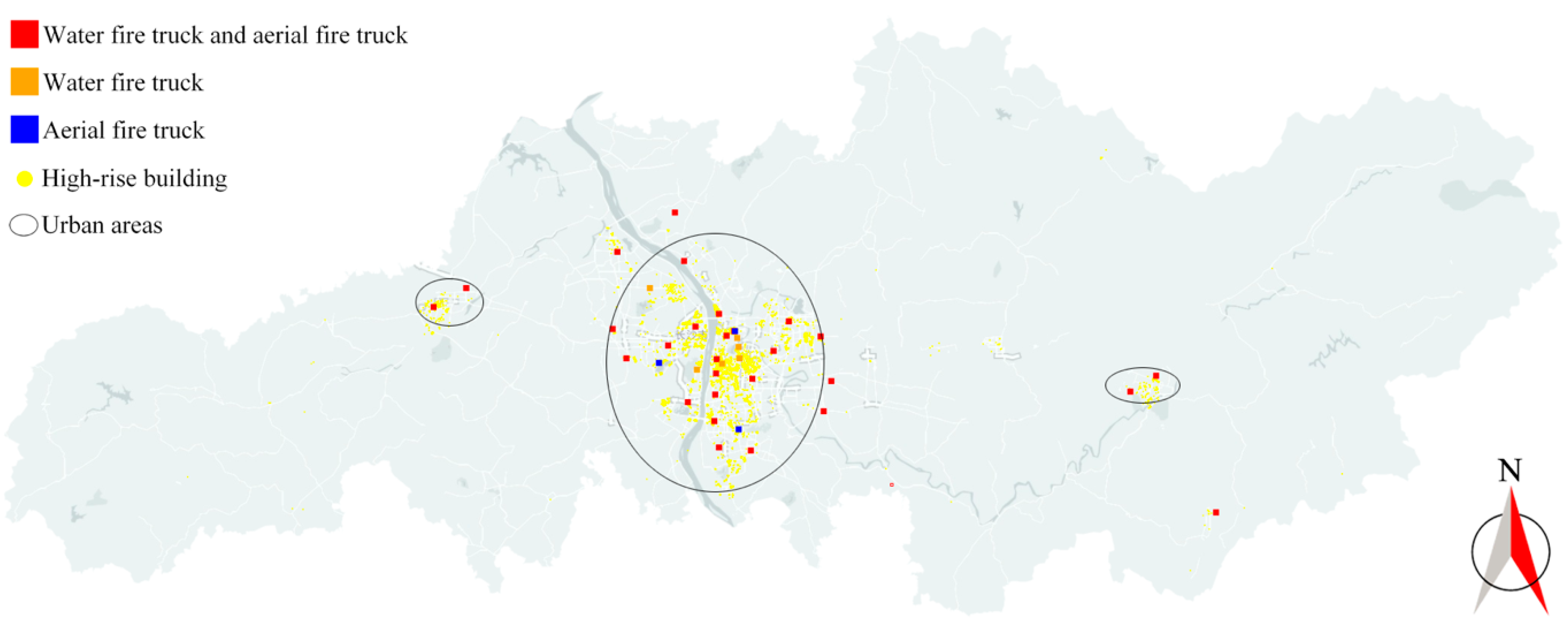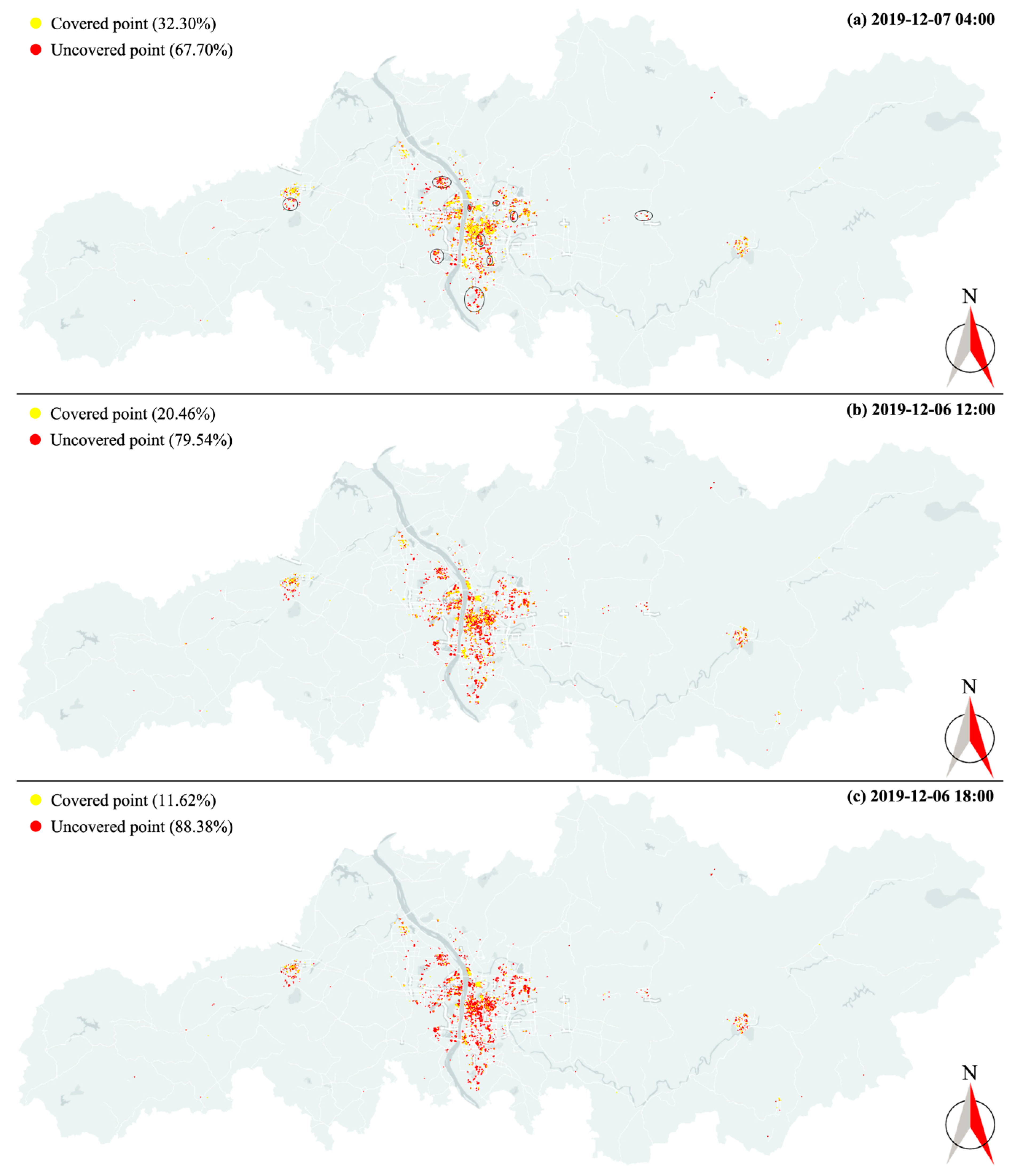Applying Real-Time Travel Times to Estimate Fire Service Coverage Rate for High-Rise Buildings
Abstract
:1. Introduction
2. Methods
2.1. Fire Apparatus Requirement
2.2. Dynamic Estimation Model
2.3. Data Extracting and Processing
3. Case Studies
3.1. Study Area and Study Data
3.2. Estimation Scenarios
3.3. Results and Discussion
4. Discussion from a National Perspective
5. Conclusions
Author Contributions
Funding
Conflicts of Interest
References
- He, Q.; Song, Y.; Liu, Y.; Yin, C. Diffusion or coalescence? Urban growth pattern and change in 363 Chinese cities from 1995 to 2015. Sustain. Cities Soc. 2017, 35, 729–739. [Google Scholar] [CrossRef]
- The Council on Tall Buildings and Urban Habitat. CTBUH Year in Review: Tall Trends of 2018. Available online: http://www.skyscrapercenter.com/research/CTBUH_ResearchReport_2018YearInReview.pdf (accessed on 2 January 2020).
- Cheema, A.R. High-rise buildings worsened heatwave. Nature 2015, 524, 35. [Google Scholar] [CrossRef] [Green Version]
- Zhou, L.; Guo, J.; Wen, X.; Ma, J.; Yang, F.; Wang, C.; Zhang, D. Monitoring and Analysis of Dynamic Characteristics of Super High-rise Buildings using GB-RAR: A Case Study of the WGC under Construction, China. Appl. Sci. 2020, 10, 808. [Google Scholar] [CrossRef] [Green Version]
- Ministry of Public Security of the People’s Republic of China (MPS). Code for Fire Protection Design of Buildings GB 50016-2014; China Planning Press: Beijing, China, 2014.
- An, M.; Wang, J. Fire Department of the Ministry of Public Security: Comprehensively Rectify Fire Hazards of High-Rise Buildings from July to December. Available online: http://news.cctv.com/2017/07/11/ARTIs8ahaS6bRhploCxR2k0y170711.shtml (accessed on 11 July 2017).
- National Fire Protection Association (NFPA). NFPA 1710: Standard for the Organization and Deployment of Fire Suppression Operations, Emergency Medical Operations, and Special Operations to the Public by Career Fire Departments; National Fire Protection Association (NFPA): Quincy, MA, USA, 2016. [Google Scholar]
- Liu, D.; Xu, Z.; Wang, Z.; Fan, C. Regional evaluation of fire apparatus requirements for petrol stations based on travel times. Process Saf. Environ. Prot. 2020, 135, 350–363. [Google Scholar] [CrossRef]
- Angle, J.; Gala, M.; Harlow, D.; Lombardo, W.; Maciuba, C. Firefighting Strategies and Tactics; Jones and Bartlett Learning: Burlington, NJ, USA, 2016. [Google Scholar]
- Chen, Z.; Li, J.; Lu, F.; Li, Q. Optimizing location of fire stations and it’s enlightenments for Xiongan New Area. J. Saf. Sci. Technol. 2018, 14, 12–17. [Google Scholar]
- Chevalier, P.; Thomas, I.; Geraets, D.; Goetghebeur, E.; Janssens, O.; Peeters, D.; Plastria, F. Locating fire stations: An integrated approach for Belgium. Socioecon. Plann. Sci. 2012, 46, 173–182. [Google Scholar] [CrossRef] [Green Version]
- Murray, A.T. Optimising the spatial location of urban fire stations. Fire Saf. J. 2013, 62, 64–71. [Google Scholar] [CrossRef]
- Yeboah, G.; Park, P.Y. Using survival analysis to improve pre-emptive fire engine allocation for emergency response. Fire Saf. J. 2018, 97, 76–84. [Google Scholar] [CrossRef]
- Veenendaal, B.; Brovelli, M.A.; Li, S. Review of Web Mapping: Eras, Trends and Directions. ISPRS Int. J. Geo-Inf. 2017, 6, 317. [Google Scholar] [CrossRef]
- Xiang, Y.; Gao, S.; Chen, Y.; Huang, J.; Xu, X. A Comparative Study of Baidu Map API, Lbs Amap Api and Google Maps API. Softw. Guid. 2017, 16, 19–21. [Google Scholar]
- Jonietz, D.; Zipf, A. Defining Fitness-for-Use for Crowdsourced Points of Interest (POI). ISPRS Int. J. Geo-Inf. 2016, 5, 149. [Google Scholar] [CrossRef] [Green Version]
- Baidu. Baidu Maps API SDK. Available online: http://lbsyun.baidu.com/ (accessed on 2 January 2019).
- Wang, S.; Xu, G.; Guo, Q. Street Centralities and Land Use Intensities Based on Points of Interest (POI) in Shenzhen, China. ISPRS Int. J. Geo-Inf. 2018, 7, 425. [Google Scholar] [CrossRef] [Green Version]
- Jiang, J.; Dai, F.; Zhang, J. Urban Functional Zone Recognition and Green Space Evaluation of Shanghai Based on POI Data. Chin. Landsc. Archit. 2019, 35, 113–118. [Google Scholar]
- Lu, T.; Lansing, J.; Zhang, W.; Bechle, M.J.; Hankey, S. Land Use Regression models for 60 volatile organic compounds: Comparing Google Point of Interest (POI) and city permit data. Sci. Total Environ. 2019, 677, 131–141. [Google Scholar] [CrossRef] [PubMed]
- Cai, M.; Lan, Z.; Zhang, Z.; Wang, H. Evaluation of road traffic noise exposure based on high-resolution population distribution and grid-level noise data. Build. Environ. 2019, 147, 211–220. [Google Scholar] [CrossRef]
- Kc, K.; Corcoran, J.; Chhetri, P. Spatial optimisation of fire service coverage: A case study of Brisbane, Australia. Geogr. Res. 2018, 56, 270–284. [Google Scholar] [CrossRef]
- Echeverria, F.; Abrego, A.; de Audicana, M.G.; Lopez-Maestresalas, A.; Arazuri, S.; Ciriza, R.; Jaren, C. Analysis of fire services coverage in Spain. DYNA 2018, 93, 247–251. [Google Scholar]
- Gu, C. Urbanization: Positive and negative effects. Sci. Bull. 2019, 64, 281–283. [Google Scholar] [CrossRef] [Green Version]
- Han, F.; Xie, R.; Lai, M. Traffic density, congestion externalities, and urbanization in China. Spat. Econ. Anal. 2018, 13, 400–421. [Google Scholar] [CrossRef]
- Lin, C.; Yu, Y.; Wu, D.; Gong, B. Traffic Flow Catastrophe Border Identification for Urban High-Density Area Based on Cusp Catastrophe Theory: A Case Study under Sudden Fire Disaster. Appl. Sci. 2020, 10, 3197. [Google Scholar] [CrossRef]
- Nimlyat, P.S.; Audu, A.U.; Ola-Adisa, E.O.; Gwatau, D. An evaluation of fire safety measures in high-rise buildings in Nigeria. Sustain. Cities Soc. 2017, 35, 774–785. [Google Scholar] [CrossRef]
- Wang, M.; Zhang, J.; Yang, L.; Yunwei, Y. Fire safety resilience assessment of high-rise buildings facing resilient city. Build. Sci. 2020, 5, 115–119. [Google Scholar]
- Shi, L.; Chew, M.Y.L.; Liu, X.; Cheng, X.; Wang, B.; Zhang, G. An experimental and numerical study on fire behaviors of charring materials frequently used in buildings. Energy Build. 2017, 138, 140–153. [Google Scholar] [CrossRef]
- Nguyen, K.T.Q.; Mendis, P.; Fernando, S. Novel modelling approach for evacuation strategies of tall towers—A case study of Lotus Tower. J. Build. Eng. 2019, 25, 100763. [Google Scholar] [CrossRef]
- Zeng, Y.; Song, W.; Huo, F.; Fang, Z.; Cao, S.; Vizzari, G. Effects of Initial Distribution Ratio and Illumination on Merging Behaviors During High-Rise Stair Descent Process. Fire Technol. 2018, 54, 1095–1112. [Google Scholar] [CrossRef]
- Wang, C.; Xia, D.; Jiang, L.; Shang, K.; Liu, H.; Xue, C.; Wu, L.; Ma, H.; Wei, H.; Zhu, X.; et al. Guidelines for Fire Fighting of High-Rise Buildings GA/T1191-2014; China Standards Press: Beijing, China, 2014. [Google Scholar]
- Zanenga, E.; Leonello, D.; Bottasso, C.L. Feasibility Study of Rotorcraft Fire Fighting for High-Rise Buildings. J. Aerosp. Eng. 2010, 23, 166–175. [Google Scholar] [CrossRef]
- Min, S.; Park, J.; Kwon, Y. A Study on the Fire Suppression in Ultra High-Buildings using Fire Department Connection. J. Korean Soc. Hazard Mitig. 2016, 16, 195–201. [Google Scholar] [CrossRef] [Green Version]
- Qiu, X.; Shen, Y.; Han, S.; Liu, H.; Qin, Y.; Zhang, X. Fire Engine Suitable for Fire-Fighting in High-Rise and Super High-Rise Buildings. U.S. Patent 9,566,459, 14 February 2017. [Google Scholar]
- Zelenkov, S.A.; Podgrushnyy, A.V.; Denisov, A.N.; Bordik, R.I. Combined method of extinguishing fires in high-rise buildings using hose-pump high pressure system. Fire Explos. Saf. 2017, 26, 56–64. [Google Scholar] [CrossRef] [Green Version]
- Ministry of Housing and Urban-Rural Development of the People’s Republic of China (MOHURD); Ministry of Public Security of the People’s Republic of China (MPS). Code for Planning of Urban Fire Control GB51080-2015; China Architecture & Building Press: Beijing, China, 2015.
- KC, K.; Corcoran, J.; Chhetri, P. Measuring the spatial accessibility to fire stations using enhanced floating catchment method. Socioecon. Plann. Sci. 2018, 69, 100673. [Google Scholar] [CrossRef]
- Changsha Bureau of Statistics. 2018 Changsha Statistical Yearbook. Available online: http://tjj.changsha.gov.cn/tjnj/2019/ (accessed on 25 January 2019).
- Guo, J.; Li, C.; Qin, X.; Huang, W.; Wei, Y.; Cao, J. Analyzing distributions for travel time data collected using radio frequency identification technique in urban road networks. Sci. China Technol. Sci. 2019, 62, 106–120. [Google Scholar] [CrossRef]
- Liu, D.; Xu, Z.; Wang, Z.; Zhou, Y.; Fan, C. Estimation of effective coverage rate of fire station services based on real-time travel times. Fire Saf. J. 2020, 103021. [Google Scholar] [CrossRef]
- Fire Department of Ministry of Public Security of the People’s Republic of China. 2018 China Fire Yearbook; Yunnan People’s Publishing House: Kunming, China, 2018.







| No. | Tj | ECR(C) | AD(C)(m) | AT(C)(s) | AV(C)(m/s) | EC(C) | UC(C) |
|---|---|---|---|---|---|---|---|
| 1 | 2019–12–02 00:00:00 | 26.60% | 3206.29 | 343.44 | 9.34 | 1369 | 3777 |
| 2 | 2019–12–02 04:00:00 | 29.83% | 3201.96 | 320.44 | 9.99 | 1535 | 3611 |
| 3 | 2019–12–02 08:00:00 | 13.00% | 3239.20 | 495.13 | 6.54 | 669 | 4477 |
| 4 | 2019–12–02 12:00:00 | 19.39% | 3205.19 | 401.58 | 7.98 | 998 | 4148 |
| 5 | 2019–12–02 18:00:00 | 13.43% | 3235.86 | 515.54 | 6.28 | 691 | 4455 |
| 6 | 2019–12–03 04:00:00 | 32.04% | 3200.63 | 312.18 | 10.25 | 1649 | 3497 |
| 7 | 2019–12–03 08:00:00 | 13.86% | 3234.02 | 466.56 | 6.93 | 713 | 4433 |
| 8 | 2019–12–03 12:00:00 | 18.66% | 3211.08 | 402.04 | 7.99 | 960 | 4186 |
| 9 | 2019–12–03 18:00:00 | 12.79% | 3254.32 | 533.20 | 6.10 | 658 | 4488 |
| 10 | 2019–12–04 04:00:00 | 31.75% | 3195.80 | 312.49 | 10.23 | 1634 | 3512 |
| 11 | 2019–12–04 08:00:00 | 14.57% | 3230.85 | 462.94 | 6.98 | 750 | 4396 |
| 12 | 2019–12–04 12:00:00 | 19.94% | 3213.55 | 397.65 | 8.08 | 1026 | 4120 |
| 13 | 2019–12–04 18:00:00 | 12.16% | 3245.46 | 520.46 | 6.24 | 626 | 4520 |
| 14 | 2019–12–05 04:00:00 | 31.69% | 3198.34 | 315.23 | 10.15 | 1631 | 3515 |
| 15 | 2019–12–05 08:00:00 | 14.34% | 3239.00 | 466.37 | 6.95 | 738 | 4408 |
| 16 | 2019–12–05 12:00:00 | 20.17% | 3211.08 | 392.82 | 8.17 | 1038 | 4108 |
| 17 | 2019–12–05 18:00:00 | 13.86% | 3233.48 | 502.94 | 6.43 | 713 | 4433 |
| 18 | 2019–12–06 04:00:00 | 31.19% | 3213.59 | 316.62 | 10.15 | 1605 | 3541 |
| 19 | 2019–12–06 08:00:00 | 15.58% | 3228.94 | 460.67 | 7.01 | 802 | 4344 |
| 20 | 2019–12–06 12:00:00 | 20.46% | 3226.81 | 400.54 | 8.06 | 1053 | 4093 |
| 21 | 2019–12–06 18:00:00 | 11.62% | 3268.52 | 555.31 | 5.89 | 598 | 4548 |
| 22 | 2019–12–07 04:00:00 | 32.30% | 3204.39 | 315.27 | 10.16 | 1662 | 3484 |
| 23 | 2019–12–07 08:00:00 | 18.91% | 3225.22 | 412.06 | 7.83 | 973 | 4173 |
| 24 | 2019–12–07 12:00:00 | 19.06% | 3244.01 | 414.45 | 7.83 | 981 | 4165 |
| 25 | 2019–12–07 18:00:00 | 13.78% | 3269.92 | 493.23 | 6.63 | 709 | 4437 |
| 26 | 2019–12–08 04:00:00 | 31.34% | 3218.67 | 317.63 | 10.13 | 1613 | 3533 |
| 27 | 2019–12–08 08:00:00 | 19.78% | 3223.77 | 404.52 | 7.97 | 1018 | 4128 |
| 28 | 2019–12–08 12:00:00 | 18.48% | 3228.30 | 414.96 | 7.78 | 951 | 4195 |
| 29 | 2019–12–08 18:00:00 | 14.85% | 3264.71 | 483.18 | 6.76 | 764 | 4382 |
| 30 | 2019–12–09 00:00:00 | 26.95% | 3216.11 | 345.06 | 9.32 | 1387 | 3759 |
| 31 | Variance | 0.50% | 414.50 | 5666.30 | 2.08 | 133,547 | 133,547 |
© 2020 by the authors. Licensee MDPI, Basel, Switzerland. This article is an open access article distributed under the terms and conditions of the Creative Commons Attribution (CC BY) license (http://creativecommons.org/licenses/by/4.0/).
Share and Cite
Liu, D.; Xu, Z.; Yan, L.; Wang, F. Applying Real-Time Travel Times to Estimate Fire Service Coverage Rate for High-Rise Buildings. Appl. Sci. 2020, 10, 6632. https://doi.org/10.3390/app10196632
Liu D, Xu Z, Yan L, Wang F. Applying Real-Time Travel Times to Estimate Fire Service Coverage Rate for High-Rise Buildings. Applied Sciences. 2020; 10(19):6632. https://doi.org/10.3390/app10196632
Chicago/Turabian StyleLiu, Dingli, Zhisheng Xu, Long Yan, and Feiyue Wang. 2020. "Applying Real-Time Travel Times to Estimate Fire Service Coverage Rate for High-Rise Buildings" Applied Sciences 10, no. 19: 6632. https://doi.org/10.3390/app10196632





